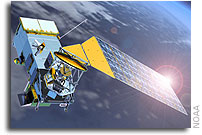Ball Aerospace Begins Final Integration and Test for NPOESS Preparatory Project OMPS Instrument

Ball Aerospace & Technologies Corp.’s Ozone Mapping and Profiler Suite (OMPS) Protoflight Model (PFM) that will fly aboard the National Polar-orbiting Operational Environmental Satellite System (NPOESS) Preparatory Project (NPP) has entered final integration and acceptance testing.
Ball Aerospace expects to complete integration and testing in August, and deliver the OMPS PFM for spacecraft integration no later than September 30. OMPS is one of five sensors built for the NPP risk reduction mission, scheduled to launch in 2010. The NPP mission, a joint effort between NASA and the NPOESS Integrated Program Office, is designed to extend key measurements in support of long-term climate trend monitoring and global biological productivity and prove technologies for the NPOESS mission.
Northrop Grumman Corp. is the prime contractor for NPOESS, leading the effort to design, develop and launch the next generation low-Earth orbiting operational environmental monitoring system.
Initial assembly has also begun on the OMPS Flight Model 2 for the first NPOESS spacecraft. Nadir sensor fabrication is well underway with both focal planes complete and fabrication of the main electronics box has begun. The OMPS FM2 delivery is scheduled for December 2010, in preparation for the NPOESS launch scheduled for 2013.
OMPS will monitor ozone from space, collect total column and vertical profile ozone data, and continue the current daily global data provided by the Solar Backscatter Ultraviolet radiometer (SBUV)/2 and Total Ozone Mapping Spectrometer (TOMS), but with higher fidelity.
Ball Aerospace is also building the NPP spacecraft, a modified Ball Commercial Platform (BCP) 2000 under a contract to the Goddard Space Flight Center Rapid Spacecraft Development Office.
Ball Aerospace & Technologies Corp. supports critical missions of important national agencies such as the Department of Defense, NASA, NOAA and other U.S. government and commercial entities. The company develops and manufactures spacecraft, advanced instruments and sensors, components, data exploitation systems and RF solutions for strategic, tactical and scientific applications. Since 1956, Ball Aerospace has been responsible for numerous technological and scientific ‘firsts’ and acts as a technology innovator for the aerospace market.
Ball Corporation (NYSE:BLL) is a supplier of high-quality metal and plastic packaging products for beverage, food and household products customers, and of aerospace and other technologies and services, primarily for the U.S. government. Ball Corporation and its subsidiaries employ more than 15,500 people worldwide and reported 2007 sales of $7.4 billion.
Forward Looking Statements:
This release contains “forward-looking” statements concerning future events and financial performance. Words such as “expects,” “anticipates,” “estimates” and similar expressions are intended to identify forward-looking statements. Such statements are subject to risks and uncertainties which could cause actual results to differ materially from those expressed or implied. The company undertakes no obligation to publicly update or revise any forward-looking statements, whether as a result of new information, future events or otherwise. Key risks and uncertainties are summarized in filings with the Securities and Exchange Commission, including Exhibit 99.2 in our Form 10-K, which are available at our Web site and at http://www.sec.gov/. Factors that might affect our packaging segments include fluctuation in product demand and preferences; availability and cost of raw materials, including recent significant increases in resin, steel, aluminum and energy costs, and the ability to pass such increases on to customers; competitive packaging availability, pricing and substitution; changes in climate and weather; crop yields; competitive activity; failure to achieve anticipated productivity improvements or production cost reductions, including our beverage can end project; mandatory deposit or other restrictive packaging laws; changes in major customer or supplier contracts or loss of a major customer or supplier; and changes in foreign exchange rates, tax rates and activities of foreign subsidiaries. Factors that might affect our aerospace segment include: funding, authorization, availability and returns of government and commercial contracts; and delays, extensions and technical uncertainties affecting segment contracts. Factors that might affect the company as a whole include those listed plus: accounting changes; changes in senior management, the current global credit squeeze, successful or unsuccessful acquisitions, joint ventures or divestitures; integration of recently acquired businesses; regulatory action or laws including tax, environmental, health and workplace safety, including in respect of chemicals or substances used in raw materials or in the manufacturing process; governmental investigations; technological developments and innovations; goodwill impairment; antitrust, patent and other litigation; strikes; labor cost changes; rates of return projected and earned on assets of the company’s defined benefit retirement plans; pension changes; reduced cash flow; interest rates affecting our debt; and changes to unaudited results due to statutory audits or other effects.









